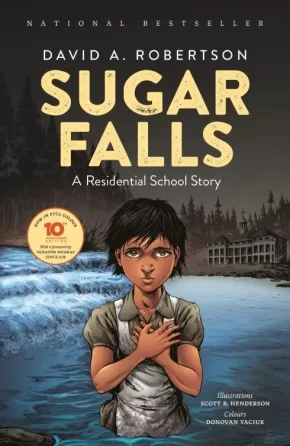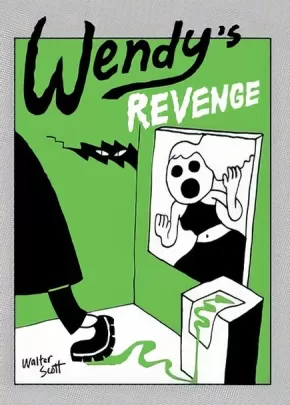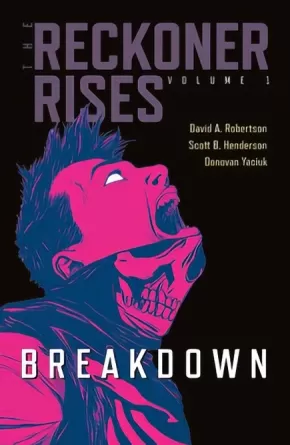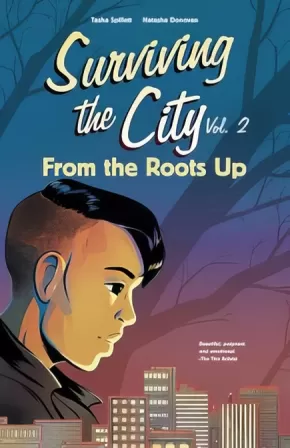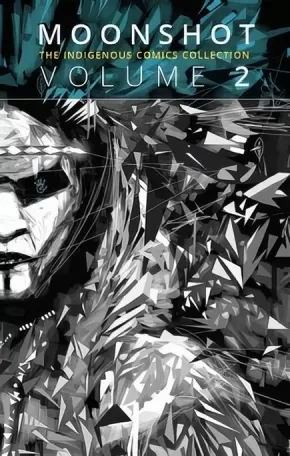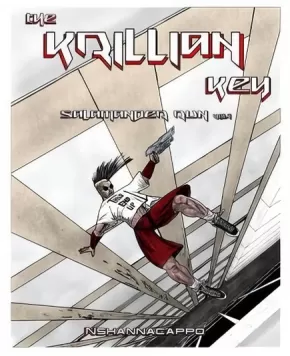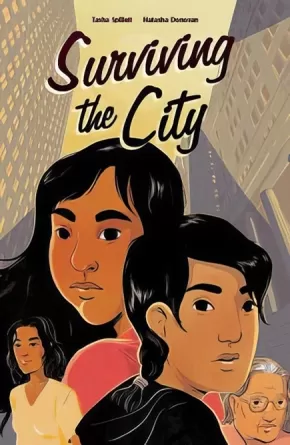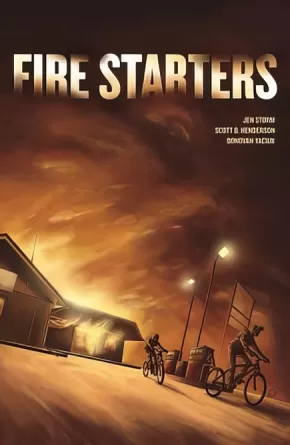
Graphic Novels
31
-
45
of
64 Results;
Sort By
Go To
of 5
Sugar Falls: A Residential School Story - 10th Anniversary Edition
$21.95
Artists:
Format:
Paperback
Text Content Territories:
Indigenous Canadian; First Nations; Cree (Nehiyawak); Woodland Cree; Rocky Cree; Cross Lake First Nation;
ISBN / Barcode: 9781553799757
Synopsis:
Synopsis:
A young girl struggles to survive residential school in this timeless graphic novel from the bestselling author of The Barren Grounds—a story of strength, family, and culture, inspired by true events, that shares the awe-inspiring resilience of Betty Ross.
Abandoned as a young child, Betsy was soon adopted into a loving family. A few short years later, at the age of 8, everything changed. Betsy was taken away to a residential school. There she was forced to endure abuse and indignity, but Betsy recalled the words her father spoke to her at Sugar Falls—words that gave her the resilience, strength, and determination to survive.
Sugar Falls is based on the true story of Betty Ross, Elder from Cross Lake First Nation. We wish to acknowledge, with the utmost gratitude, Betty’s generosity in sharing her story. A portion of the proceeds from the sale of Sugar Falls goes to support the bursary program for The Helen Betty Osborne Memorial Foundation.
Educator Information
Recommended for grades 9 to 12.
This 10th-anniversary edition brings David A. Robertson’s national bestseller to life in full colour, with a foreword by Senator Murray Sinclair, Chairman of the Truth and Reconciliation Commission of Canada, and a touching afterword from Elder Betty Ross herself.
A Teacher Guide is available for this work: Teacher Guide for Sugar Falls: Learning About the History and Legacy of Residential Schools in Grades 9-12
Additional Information
48 pages | 6.50" x 10.00" | full colour throughout
Teacher Guide for A Girl Called Echo: Learning About the History and Culture of the Metis Nation in Grades 6-8
$25.95
Format:
Coil Bound
Text Content Territories:
Indigenous Canadian; Métis;
ISBN / Barcode: 9781774920190
Synopsis:
Synopsis:
The A Girl Called Echo series tells the story of Métis teenager Echo Desjardins, who is struggling to adjust to a new school and a new home while in foster care. Readers follow Echo as she travels through time and experiences pivotal events from Métis history, gains new perspectives about where she came from, and imagines what the future might hold.
Written by Anishinaabe educator Reuben Boulette, the Teacher Guide for A Girl Called Echo includes
- lesson plans specific to each book in the A Girl Called Echo series
- original articles outlining the history of the Métis Nation and their fight for sovereignty
- in-depth reading activities that engage students’ critical thinking skills
- activities that introduce students to the critical study of graphic novels and sequential art
This teacher guide will engage students’ understanding of Métis history and culture and encourage reflection on the importance of learning Indigenous histories.
Educator Information
Recommended for grades 6 to 8.
Find the A Girl Called Echo Series HERE!
Additional Information
72 pages | 8.50" x 11.00" | Spiral Bound
Wendy (2 in Stock)
$24.95
Format:
Paperback
ISBN / Barcode: 9781770464841
Synopsis:
Synopsis:
The outrageously funny and painfully relatable satire of an aspiring artist and millennial culture.
Walter Scott’s Wendy comics have become a critical sensation, with rave reviews in The New Yorker and The Guardian, and an appearance in the Best American Comics anthology. Learn Wendy’s origin story as Scott hilariously plumbs millennial culture, creative ennui, and the nepotism of the art world’s institutions.
Wendy’s an aspiring artist in a party city, and she’s in a rut. She spends her time snorting MDMA in gallery bathrooms and watching Nurse Jackie reruns on her laptop while hungover. So when she’s accepted into the prestigious Flojo Island residency, Wendy vows to buckle down and get working. But during the remote, woodsy residency, Wendy and her collaborator/bff Winona put on a performance piece that becomes the centre of an art world controversy, and so Wendy returns to Montreal, getting a job in a coffee shop to make ends meet.
With Wendy, Scott launches the Wendyverse, brimming with painfully relatable characters like the back-stabbing frenemy Tina, the name-dropping Paloma, the cool drummer Wendy obsesses over, Jeff, and of course, our treasured Wendy, the hot mess we can’t live without. In blunt, laugh out loud funny vignettes with perfect punchlines, Scott illuminates the opacity of artspeak and the ceaseless anxieties plaguing a largely privileged generation.
Reviews
“Wendy’s lust for life is inseparable from her knee-jerk self-destruction.”–The New Yorker
“Winningly messy.”—The Guardian
“The art school party girl who is perhaps the real voice of our generation (sorry Lena Dunham).”—Vice
Educator Information
Publisher recommends for ages 16+.
Caution: mature content (swearing and strong language, sexual content, drug/alcohol use, etc.)
Additional Information
216 pages | 6.50" x 9.00" | black and white illustrations throughout | paperback
Wendy, Master of Art (1 in Stock)
$29.95
Format:
Paperback
Text Content Territories:
Indigenous Canadian;
ISBN / Barcode: 9781770463998
Synopsis:
Synopsis:
"[In Wendy, Master of Art,] Scott manages a rare thing: the sharpness of his satire doesn’t preclude a realistic rendering of personhood, and the seeming flatness opens up, at every turn, to a depth of feeling…. His mastery of his characters’ faces and gestures is also wonderful, his line quick and sure and expressive." —The New Yorker
The existential dread of making (or not making) art takes center stage in this trenchant satire of MFA culture.
Wendy is an aspiring contemporary artist whose adventures have taken her to galleries, art openings, and parties in Los Angeles, Tokyo, and Toronto. In Wendy, Master of Art, Walter Scott’s sly wit and social commentary zero in on MFA culture as our hero hunkers down to complete a master of fine arts at the University of Hell in small-town Ontario.
Finally Wendy has space to refine her artistic practice, but in this calm, all of her unresolved insecurities and fears explode at full volume—usually while hungover. What is the post-Jungian object as symbol? Will she ever understand her course reading—or herself? What if she’s just not smart enough? As she develops as an artist and a person, Wendy also finds herself in a teaching position, mentoring a perpetually sobbing grade-grubbing undergrad.
Scott’s incisively funny take on art school pretensions isn’t the only focus. Wendy, Master of Art explores the politics of open relationships and polyamory, performative activism, the precariousness of a life in the arts, as well as the complexities of gender identity, sex work, drug use, and more. At its heart, this is a book about the give and take of community—about learning to navigate empathy and boundaries, and to respect herself. It is deeply funny and endlessly relatable as it shows Wendy growing from millennial art party girl to successful artist, friend, teacher—and Master of Art.
Reviews
"Wendy’s personal life remains chaotic, hilarious, and relatable…" —Quill & Quire
Educator Information
The publisher recommends for ages 16+, but this graphic novel contains very mature content.
Caution: Mature content
This is the third and largest book in the Wendy series.
Additional Information
276 pages | 6.52" x 9.07" | Black-and-white illustrations | Paperback
Wendy's Revenge (1 in Stock, Out of Print)
$24.95
Format:
Paperback
Text Content Territories:
Indigenous Canadian;
ISBN / Barcode: 9781770464858
Synopsis:
Synopsis:
This critique of the art world will have you crying with laughter
In Wendy’s Revenge, Scott’s titular heroine returns with a fresh set of awkward misadventures and messy nights out. When the book opens, aspiring artist Wendy has decided to move to the west coast to clear her head.
She plans on getting some quality time with her collaborator and friend Winona, only to find Winona packing up to leave, having decided to move back in with her mom on the rez. All alone, Wendy endeavours to foster community in Vancouver’s bleak art scene. When her hope and optimism are all used up, she packs her bags for an artist residency in Japan. Wendy then gallery hops and parties around the globe until she stumbles upon the opportunity to unite with former foe Paloma. Together they enact revenge on VVURST, the German publication that once tore her performance art to shreds.
Young artists struggle with mental health issues, they get wasted and hook up with men with gross piercings, and they’re afflicted with an insatiable longing for a stable identity—stability they themselves undermine. Scott’s deceptively simple, inky character drawings evoke millennial culture with such Jungian accuracy that you can’t help but stare and giggle in equal measure. Praised by The New Yorker, Guardian, Globe and Mail, and with an appearance in the Best American Comics anthology, it’s clear why Walter Scott’s Wendy comics have taken critics by storm.
Reviews
“I am blown away by Walter Scott’s Wendy series.” —Zadie Smith
“Wendy, her pals and her milieu comprise a fictional world as fully and funnily inhabited as any in recent Canadian storytelling.”—Globe & Mail
“Funny, poignant, and scary. Scott makes you laugh and then rips your heart out.”—Literary Hub
Educator Information
The publisher recommends for ages 16+, but this graphic novel contains very mature content.
Caution: Mature content
In this second comic, Winona, an Indigenous character, is introduced.
Additional Information
260 pages | 6.50" x 9.00" | Black-and-white illustrations with partial color section | Paperback
Breakdown
$21.95
Artists:
Format:
Paperback
Text Content Territories:
Indigenous Canadian;
ISBN / Barcode: 9781553798903
Synopsis:
Synopsis:
Acclaimed writer, David A. Robertson, delivers suspense, adventure, and humour in this stunningly illustrated graphic novel continuation of The Reckoner trilogy.
After the events in Wounded Sky, Cole and Eva arrive in Winnipeg, the headquarters of Mihko Laboratories. They are intent on destroying the company once and for all, but their plans are thwarted when a new threat surfaces. When Cole becomes mired in terrifying visions, Eva must harness her newly discovered powers to investigate Mihko without him. Are Cole’s visions just troubled dreams or are they leading him to a horrible truth?
Perfect for fans of superheroes, The Bloodhound Gang returns in this all-new graphic novel series, The Reckoner Rises.
Reviews
“David A. Robertson's powerful Indigenous YA trilogy gets a comic-book continuation, a natural format for the adventures of an anxious teen turned tormented superhero.” - Quill & Quire
Educator & Series Information
Recommended for grades 8 to 12.
This book is part of the graphic novel series, The Reckoner Rises, a continuation of The Reckoner trilogy.
Additional Information
72 pages | 6.50" x 10.00"
From the Roots Up: Surviving the City Vol. 2
$21.95
Artists:
Format:
Paperback
Text Content Territories:
Indigenous Canadian; First Nations; Anishinaabeg; Cree (Nehiyawak);
ISBN / Barcode: 9781553798989
Synopsis:
Synopsis:
Dez and Miikwan’s stories continue in this sequel to Surviving the City.
Dez’s grandmother has passed away. Grieving, and with nowhere else to go, she’s living in a group home. On top of everything else, Dez is navigating a new relationship and coming into her identity as a Two-Spirit person.
Miikwan is crushing on the school’s new kid Riel, but doesn’t really understand what Dez is going through. Will she learn how to be a supportive ally to her best friend?
Elder Geraldine is doing her best to be supportive, but she doesn’t know how to respond when the gendered protocols she’s grown up with that are being thrown into question.
Will Dez be comfortable expressing her full identity? And will her community relearn the teachings and overcome prejudice to celebrate her for who she is?
Educator & Series Information
Recommended for ages 12 to 18.
This is the second volume in the Surviving the City graphic novel series, which is also part of the Debwe Series.
Surviving the City is a contemporary graphic novel series about young Indigenous women navigating their way in an urban environment. It includes these books:
Surviving the City
From the Roots Up
We Are the Medicine
A Teacher Guide is available: Surviving the City Teacher Guide: Exploring Identity, Allyship, and Social Action for Meaningful Change in Grades 7-12
Additional Information
64 pages | 6.50" x 10.00"
Moonshot: The Indigenous Comics Collection Volume 2
$19.95
Artists:
Editors:
Format:
Paperback
Text Content Territories:
Indigenous Canadian;
ISBN / Barcode: 9780228706212
Synopsis:
Synopsis:
MOONSHOT: The Indigenous Comics Collection brings together dozens of creators from North America to contribute comic book stories showcasing the rich heritage and identity of indigenous storytelling. From traditional stories to exciting new visions of the future, this collection presents some of the finest comic book and graphic novel work on the continent.
Educator & Series Information
Inhabit Education Books is proud to distribute this important collection of Indigenous comic stories, originally published by Alternate History Comics. Moonshot has been published under Avani, an imprint featuring titles that extend beyond the Canadian North, giving readers the opportunity to explore cultures and stories from all over Canada and around the world.
Ages 12+
This is volume 2 in the Moonshot series.
Additional Information
165 pages | 6.50" x 10.25" | colour illustrations
Moonshot: The Indigenous Comics Collection Volume 3
$23.95
Artists:
Editors:
Format:
Paperback
Text Content Territories:
Indigenous Canadian;
ISBN / Barcode: 9780228706229
Synopsis:
Synopsis:
MOONSHOT: The Indigenous Comics Collection brings together dozens of creators from North America to contribute comic book stories showcasing the rich heritage and identity of indigenous storytelling. From traditional stories to exciting new visions of the future, this collection presents some of the finest comic book and graphic novel work on the continent.
Educator & Series Information
Inhabit Education Books is proud to distribute this important collection of Indigenous comic stories, originally published by Alternate History Comics. Moonshot has been published under Avani, an imprint featuring titles that extend beyond the Canadian North, giving readers the opportunity to explore cultures and stories from all over Canada and around the world.
Ages 12+
This is volume 3 in the series.
Additional Information
144 pages | 6.50" x 10.25" | colour illustrations
Northwest Resistance
$21.95
Artists:
Format:
Paperback
Text Content Territories:
Indigenous Canadian; Métis;
ISBN / Barcode: 9781553798316
Synopsis:
Synopsis:
Echo Desjardins is adjusting to her new home, finding friends, and learning about Métis history. She just can’t stop slipping back and forth in time. One ordinary afternoon in class, Echo finds herself transported to the banks of the Red River in the summer of 1869. All is not well in the territory as Canadian surveyors have arrived to change the face of territory, and Métis families, who have lived there for generations, are losing access to their land. As the Resistance takes hold, Echo fears for her friends and the future of her people in the Red River Valley.
Educator & Series Information
This is volume 3 in the graphic novel series, A Girl Called Echo, by Katherena Vermette.
Books in this series include:
Volume 1: Pemmican Wars
Volume 2: Red River Resistance
Volume 3: Northwest Resistance
Volume 4: Road Allowance Era
Recommended for grades 5 to 9 by publisher.
Katherena Vermette, a Governor General's Award-winning author deftly enters a format typically dominated by male creators with this graphic novel series, A Girl Called Echo. Featuring compelling illustrations, a female main character, and the contemporary foster care system, the series follows Echo Desjardins as she discovers her Métis heritage firsthand while slipping back and forth through time.
This book is available in French: Elle s'appelle Echo Tome 3: La résistance du Nord-Ouest
Additional Information
48 pages | 6.50" x 10.00"
The Krillian Key: Salamander Run
$24.00
Format:
Paperback
Text Content Territories:
Indigenous;
ISBN / Barcode: 9781928120216
Synopsis:
Synopsis:
“My million years of immortality have barely begun…”
Pursued by warring human/alien hybrids, the immortal Kyrill, also known as Salamander, is the key to a prison forged by the seven gods of creation. While one of the warring factions moves to protect him, the other seeks to use him to open the prison. Kyrill’s story unfolds in a war-ravaged dystopia where his people, Indigenous North Americans, are space pirates who control the solar system’s spaceways. The Krillian Key: Salamander Run is a fun, sassy and fast-paced graphic novel set in the post-apocalyptic future of Neo-New York circa 2242, with flashbacks to modern-day Canada.
Additional Information
200 pages | 5.50" x 8.50" | black and white illustrations
Pemmican Wars
$21.95
Artists:
Format:
Paperback
Text Content Territories:
Indigenous Canadian; Métis;
ISBN / Barcode: 9781553796787
Synopsis:
Synopsis:
Echo Desjardins, a 13-year-old Métis girl adjusting to a new home and school, is struggling with loneliness while separated from her mother. Then an ordinary day in Mr. Bee’s history class turns extraordinary, and Echo’s life will never be the same. During Mr. Bee’s lecture, Echo finds herself transported to another time and place—a bison hunt on the Saskatchewan prairie—and back again to the present. In the following weeks, Echo slips back and forth in time. She visits a Métis camp, travels the old fur-trade routes, and experiences the perilous and bygone era of the Pemmican Wars.
Educator & Series Information
Recommended for ages 12+ by the publisher.
Pemmican Wars is the first graphic novel in the A Girl Called Echo series.
Books in this series include:
Volume 1: Pemmican Wars
Volume 2: Red River Resistance
Volume 3: Northwest Resistance
Volume 4: Road Allowance Era
The Canadian Indigenous Books for School list recommends this for Grades 5-12 for these subject areas: Arts Education, English Language Arts, Social Studies.
This book is available in French: Elle s'appelle Echo Tome 1: La guerre du Pemmican
Additional Information
48 pages | 6.50" x 10.00"
Red River Resistance
$21.95
Artists:
Format:
Paperback
Text Content Territories:
Indigenous Canadian; Métis;
ISBN / Barcode: 9781553797470
Synopsis:
Synopsis:
Echo Desjardins is adjusting to her new home, finding friends, and learning about Métis history. She just can’t stop slipping back and forth in time. One ordinary afternoon in class, Echo finds herself transported to the banks of the Red River in the summer of 1869. All is not well in the territory as Canadian surveyors have arrived to change the face of territory, and Métis families, who have lived there for generations, are losing access to their land. As the Resistance takes hold, Echo fears for her friends and the future of her people in the Red River Valley.
Educator & Series Information
Recommended for grades 5 to 9.
Red River Resistance is volume two in the graphic novel series, A Girl Called Echo, by Katherena Vermette.
Books in this series include:
Volume 1: Pemmican Wars
Volume 2: Red River Resistance
Volume 3: Northwest Resistance
Volume 4: Road Allowance Era
Recommended in the Canadian Indigenous Books for Schools 2019-2020 resource list as being useful for grades 5-12 with regard to these subjects: English Language Arts, Art Education, Social Studies.
This book is available in French: Elle s'appelle Echo Tome 2: La guerre du Pemmican
Additional Information
47 pages | 6.50" x 10.00"
Surviving the City Vol. 1
$21.95
Artists:
Format:
Paperback
Text Content Territories:
Indigenous Canadian; First Nations; Cree (Nehiyawak); Anishinaabeg;
ISBN / Barcode: 9781553797562
Synopsis:
Synopsis:
Tasha Spillett’s graphic novel debut, Surviving the City, is a story about womanhood, friendship, colonialism, and the anguish of a missing loved one.
Miikwan and Dez are best friends. Miikwan is Anishinaabe; Dez is Inninew. Together, the teens navigate the challenges of growing up in an urban landscape – they’re so close, they even completed their Berry Fast together. However, when Dez’s grandmother becomes too sick, Dez is told she can’t stay with her anymore. With the threat of a group home looming, Dez can’t bring herself to go home and disappears. Miikwan is devastated, and the wound of her missing mother resurfaces. Will Dez’s community find her before it’s too late? Will Miikwan be able to cope if they don’t?
Awards
- Winner of the 2019 Indigenous Voices Award for Works in an Alternative Format
- Co-winner of the Eileen McTavish Sykes Award for Best First Book by a Manitoba Author
- Winner of the Manuela Dias Design and Illustration Award, Graphic Novel category
Educator & Series Information
Recommended Grades: 7-12.
This graphic novel is part of the Surviving the City series, which is also part of the Debwe Series.
The Surviving the City series includes these titles:
- Surviving the City
- From the Roots Up
- We Are the Medicine
Recommended in the Canadian Indigenous Books for Schools 2019-2020 resource list for grades 10 to 12 for English Language Arts and Social Studies.
This book could be triggering for some readers as it contains mature content and focuses on issues such as Missing and Murdered Indigenous Women and Girls.
A Teacher Guide is available: Surviving the City Teacher Guide: Exploring Identity, Allyship, and Social Action for Meaningful Change in Grades 7-12
Additional Information
56 pages | 6.50" x 10.00"
Fire Starters
$18.95
Artists:
Format:
Paperback
Text Content Territories:
Indigenous Canadian; First Nations;
ISBN / Barcode: 9781553796855
Synopsis:
Synopsis:
Looking for a little mischief after finding an old flare gun, Ron and Ben suddenly find themselves in trouble when the local gas bar on Agamiing Reserve goes up in flames, and they are wrongly accused of arson by the sheriff’s son. As the investigation goes forward, community attitudes are revealed, and the truth slowly comes to light.
Reviews
"Storm's story is a very thoughtful look at the two systems of justice. The Native boys in the White system, being interrogated is a stark contrast to what the White boy experiences in the Native system of justice. It points to the path Storm is looking for: how a community can heal, rather than how it could punish and inflict more harm on people... I recommend Jen Storm's Fire Starters. There's a lot to study, think about, and of course, talk about." -- Debbie Reese, American Indians in Children's Literature
"Fire Starters reminds readers of the many perspectives involved in reconciliation. The story moves beyond Ron and Ben’s experiences as aboriginal teens poorly treated by a white community to include the experiences of law enforcement officers, family members, and even the arsonists themselves. Complementing the fast-paced plot, Henderson’s artwork is drawn from a wide variety of perspectives, and Yaciuk’s moody colours suit the rising tension experienced by all characters. A cautionary tale about the consequences of prejudice and racism, Fire Starters is a valuable addition to conversations about the importance of reconciliation and the power of the truth." -- Roseanne Gauthier, National Reading Campaign
Educator & Series Information
Recommended Grades: 6-9
Fire Starters is one book in The Debwe Series. This series features exceptional Indigenous writing from across Canada.
Sort By
Go To
of 5

